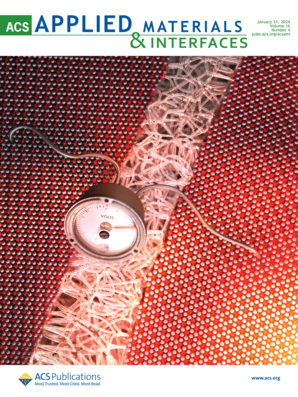Understanding the Role of Microstructure in Ti3C2Tx MXene Membrane Performance.
IF 8.3
2区 材料科学
Q1 MATERIALS SCIENCE, MULTIDISCIPLINARY
引用次数: 0
Abstract
Ti3C2Tx MXene membranes have attracted considerable interest for separation technologies owing to their well-defined and tunable interlayer channels. However, reported water permeability values vary widely, suggesting the presence of additional, unrecognized factors influencing water transport. In this study, we demonstrate that both the dynamic microstructure of MXene membranes under pressure and the flake size of Ti3C2Tx, used in fabrication play critical roles in determining water flux. We observed a substantial decline in water permeability, from tens of L/m2·bar·h to below 5 L/m2·bar·h, during filtration, attributed to compaction of the initially loose membrane structure. Notably, the change in the microstructure is reversible, with the disordered microstructure recovering after drying. Moreover, MXene flake size is found to impact the tortuosity of water pathways, where membranes constructed from smaller flakes exhibit higher permeability. For example, membranes fabricated with an average flake size of 4 μm achieved water permeabilities 2.15 times lower than those made with 0.17 μm flakes. These findings underscore the complex interplay between microstructure dynamics, flake size, and liquid transport, offering key insights for the rational design of high-performance MXene-based separation membranes.微观结构对Ti3C2Tx MXene膜性能影响的研究
Ti3C2Tx MXene膜由于具有良好定义和可调的层间通道而引起了人们对分离技术的极大兴趣。然而,报道的水渗透性值差异很大,这表明存在其他未被识别的影响水输送的因素。在这项研究中,我们证明了MXene膜在压力下的动态微观结构和制备中使用的Ti3C2Tx薄片尺寸对水通量的决定起着关键作用。我们观察到,在过滤过程中,由于最初松散的膜结构被压实,水渗透性大幅下降,从数十L/m2·bar·h降至5 L/m2·bar·h以下。值得注意的是,微观结构的变化是可逆的,干燥后无序的微观结构恢复。此外,研究发现MXene薄片的大小会影响水通道的弯曲度,其中由较小薄片构成的膜具有更高的渗透性。例如,平均薄片尺寸为4 μm的膜的透水性比平均薄片尺寸为0.17 μm的膜低2.15倍。这些发现强调了微观结构动力学、薄片尺寸和液体输运之间复杂的相互作用,为合理设计高性能mxene基分离膜提供了关键见解。
本文章由计算机程序翻译,如有差异,请以英文原文为准。
求助全文
约1分钟内获得全文
求助全文
来源期刊

ACS Applied Materials & Interfaces
工程技术-材料科学:综合
CiteScore
16.00
自引率
6.30%
发文量
4978
审稿时长
1.8 months
期刊介绍:
ACS Applied Materials & Interfaces is a leading interdisciplinary journal that brings together chemists, engineers, physicists, and biologists to explore the development and utilization of newly-discovered materials and interfacial processes for specific applications. Our journal has experienced remarkable growth since its establishment in 2009, both in terms of the number of articles published and the impact of the research showcased. We are proud to foster a truly global community, with the majority of published articles originating from outside the United States, reflecting the rapid growth of applied research worldwide.
 求助内容:
求助内容: 应助结果提醒方式:
应助结果提醒方式:


